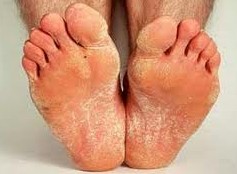Nail Fungus Causes
Causes
 Dermophytes are responsible for most fungal infections. They are parasitic fungi and depend on the nutrients in the host. For example they could feed on the dead tissue of hair, skin and nails. These fungi are tiny microscopic organisms which could infect your hair, skin or nails.
Dermophytes are responsible for most fungal infections. They are parasitic fungi and depend on the nutrients in the host. For example they could feed on the dead tissue of hair, skin and nails. These fungi are tiny microscopic organisms which could infect your hair, skin or nails.
Places where fungal infections could occur
Generally these fungal infections can be found in the warm and damp areas of the skin such as:
- Between fingers
- Between toes
- Toenail
- Fingernail
- Armpits
- Groin
How fungal infections spread
- Through contact with the infected area
- Through clothing (towels, pillows etc), pets and hair combs.
Treatment of fungal infections
Treatment depends on the correct diagnoses of fungal infections. When skin from the affected area is examined under a microscope the fungus involved can be identified.
Causes and symptoms typically attributed to fungal infections
Here are a few common causes and symptoms which are typical of fungal infections:
Ringworm
- Causes: Ringworm is also called dermatophytosis. It is a parasitic infection caused by certain species of fungi. It is caused by dermatophytes of genre Trichophyton and Microsporum.
- Symptom: As the name ringworm suggests, it occurs as pinkish or reddish circular rashes with tendency to itch. The center portion of the ring is usually clear. It could start off in one area of the skin and spread to other areas.
Jock itch
- Causes: It is a fungal infection of the groin and upper thighs caused by fungi such as Candida albicans
- Symptom: Jock itch is a very itchy ring shaped rash. Sometimes these rashes could be painful. People suffering from this infection should not wear tight fitting clothes.
Athlete’s foot
- Causes:This is commonly referred to as the ringworm of the foot and is caused by the parasitic fungus Trichophyton rubrum or Trichophyton mentagrophytes
- Symptom: Athlete’s foot appears as a scaly and sore infection usually between the toes. It first appears as a rash and unless treated quickly could lead to bacterial infection of the skin.
Scalp Ringworm
- Causes: It is also referred to as Tinea Capitis.
- Symptoms: The infected scalp tends to become itchy with patches of hair loss. Sometimes this infection shows no clinical signs or symptoms but hair loss can be seen on the scalp at the place where infection has set in. If not treated immediately, the infection could spread to other areas of the scalp.
Nail Ringworm
- Causes: This infection is also called Onychomycosis and is caused by dermatophytes, candida and molds (non-dermatophytic).
- Symptoms: When the ringworm infects the nail the infected nail tends to become thick and could detach itself from the rest of the nail. Ringworm usually attacks the toenail more than fingernails.
Fungal infections caused by yeast like fungi (candida)
Here are a few common causes and symptoms typical of fungal infections caused by yeast like fungi (candida).
Diaper rash
- Causes: The cause of Diaper Rash is not because of the diaper but because of the materials trapped by the diaper, like in baby diapers it could be minute traces of feces. This is a type of irritant contact skin irritation. It could also occur if soiled diapers are left too long.
- Symptoms: It can turn baby skin sore, tender, red and scaly.
Oral thrush
- Causes: This occurs when the mucous membranes of the mouth gets infected by yeast fungi of the genus candida.
- Symptoms: The mucosa of the mouth gets inflamed. Thick white or cream colored deposits can be found on mucosal membranes in the mouth.
Cutaneous candidiasis
- Causes: Diabetes and obese people are more prone to this infection which is basically an infection of the skin with candida yeast.
- Symptoms: It could occur with severe itching, skin lesions or rashes especially in genitals, buttocks, under the breasts or other areas of the body.
Fungal infection of internal organs like lungs
Even the lungs are susceptible to fungal infections as a result of airborne fungi and those found in air-vents etc. This condition is referred to as aspergillosis. Usually a person who already had lung disease is more prone to fungal infections of the lungs.